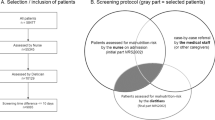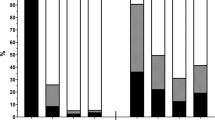Abstract
Background/Objectives:
Nutrition screening should be initiated on hospital admission by non-dietitians. This research aimed to validate and assess the reliability of the Canadian Nutrition Screening Tool (CNST) in the ‘real-world’ hospital setting.
Subjects/Methods:
Adult patients were admitted to surgical and medical wards only (no palliative patients). Study 1—Nutrition Care in Canadian Hospitals (n=1014): development of the CNST (3 items: weight loss, decrease food intake, body mass index (BMI)) and exploratory assessment of its criterion and predictive validity. Study 2—Inter-rater reliability and criterion validity assessment of the tool completed by untrained nursing personnel or diet technician (DT) (n=150). Subjective Global Assessment performed by site coordinators was used as a gold standard for comparison.
Results:
Study 1: The CNST completed by site coordinators showed good sensitivity (91.7%) and specificity (74.8%). Study 2: In the subsample of untrained personnel (160 nurses; one DT), tool’s reliability was excellent (Kappa=0.88), sensitivity was good (>90%) but specificity was low (47.8%). However, using a two-item (‘yes’ on both weight change and food intake) version of the tool improved the specificity (85.9%). BMI was thus removed to promote feasibility. The final two-item tool (study 1 sample) has a good predictive validity: length of stay (P<0.001), 30-day readmission (P=0.02; X2 5.92) and mortality (P<0.001).
Conclusions:
The simple and reliable CNST shows good sensitivity and specificity and significantly predicts adverse outcomes. Completion by several untrained nursing personnel confirms its utility in the nursing admission assessment.
This is a preview of subscription content, access via your institution
Access options
Subscribe to this journal
Receive 12 print issues and online access
$259.00 per year
only $21.58 per issue
Buy this article
- Purchase on Springer Link
- Instant access to full article PDF
Prices may be subject to local taxes which are calculated during checkout

Similar content being viewed by others
References
Tappenden KA, Quatrara B, Parkhurst ML, Malone AM, Fanjiang G, Ziegler TR . Critical role of nutrition in improving quality of care: an interdisciplinary call to action to address adult hospital malnutrition. JPEN J Parenter Enteral Nutr 2013; 37: 482–497.
Laporte M, Villalon L, Payette H . Simple nutrition screening tools for healthcare facilities: development and validity assessment. Can J Diet Pract Res 2001; 62: 26–34.
Singh H, Watt K, Veitch R, Cantor M, Duerksen D . Malnutrition is prevalent in hospitalized medical patients: Are housestaff identifying the malnourished patient? Nutrition 2006; 22: 350–354.
Allard JP, Keller HH, Jeejeebhoy KN, Laporte M, Duerksen D, Gramlich L et al. Contributors to malnutrition at hospital admission and impact on length of stay: a prospective cohort study. JPEN J Parenter Enteral Nutr 2014, (submitted for publication).
Mueller C, Compher C, Dryan ME . A.S.P.E.N. clinical guidelines. Nutrition screening, assessment, and intervention in adults. JPEN J Parenter Enteral Nutr 2011; 35: 16–24.
Kondrup J, Allison SP, Elia M, Vellas B, Plauth M . ESPEN guidelines for nutrition screening 2002. Clin Nutr 2003; 22: 415–421.
Joint Commission on Accreditation of Healthcare Organizations Comprehensive Accreditation Manual for Hospitals. Joint Commission on Accreditation of Healthcare organizations: Chicago, 2007.
Dutch Malnutrition Screening Group: The Dutch Approach in 10 Steps www.fightmalnutrition.eu2014.
Omidvari AH, Vali Y, Murray SM, Wonderling D, Rashidian A . Nutritional screening for improving professional practice for patient outcomes in hospital and primary care settings. Cochrane Database Syst Rev 2013; 6: CD005539.
American Dietetic Association. Nutrition Care Process and Model Part 1: The 2008 Update. Topics of professional interest. J Am Diet Assoc 2008; 108: 1113–1117.
Skipper A, Ferguson M, Thompson K, Castellanos VH, Porcari J . Nutrition Screening Tools: an analysis of the evidence. JPEN J Parenter Enteral Nutr 2012; 36: 292–298.
Keller HH, Dietitian of Canada 2012 On-line Courses: Nutrition Screening.
Laporte M, Villalon L, Thibodeau J, Payette H . Validity and reliability of simple nutrition screening tools adapted to the elderly population in healthcare facilities. J Nutr Health Aging 2001; 5: 292–294.
Ferguson M, Capra S, Bauer J, Banks M . Development of a valid and reliable Malnutrition Screening Tool for adult acute hospital patients. Nutrition 1999; 15: 458–464.
Rubenstein LZ, Harker JO, Salva A, Guigoz Y, Vellas B . Screening for undernutrition in geriatric practice: developing the Short-Form Mini-Nutritional Assessment (MNA-SF). J Gerontol 2001; 56: M366–M372.
Kondrup J, Rasmussen HH, Hamberg O, Stanga Z Ad Hoc ESPEN Working Group. Nutritional risk screening (NRS 2002): a new method based on an analysis of controlled trials. Clin Nutr 2003; 22: 321–336.
Elia M Chairman and Editor (2003) Screening for malnutrition; a multidisciplinary responsibility. Development and use of the MUST for adults. Malnutrition Advisory Group (MAG), a standing committee of BAPEN. Redditch, Works: BAPEN.
Kruizenga HM, Seidell JC, de Vet HCW, Wierdsma NJ, van Bokhorst-de-van der Schuren MAE . Development and validation of a hospital screening tool for malnutrition: the short nutritional assessment questionnaire (SNAQ©). Clin Nutr 2005; 24: 75–82.
Lim SL, Ang E, Foo YL, Ng LY, Tong CY, Ferguson M et al. Validity and reliability of nutrition screening administered by nurses. Nutr Clin Pract 2013; 28: 730–736.
Neelemaat F, Meijers J, Kruizenga H, van Ballegooijen H, van Bokhorst-de van der S . Comparison of five malnutrition screening tools in one hospital inpatient sample. J Clin Nurs 2011; 20: 2144–2152.
Nursal TZ, Noyan T, Atalay BG, Koz A, Karakayali H . Simple two-part tool for screening of malnutrition. Nutrition 2005; 21: 659–665.
Kyle UG, Kossovsky MP, Karsegard VL, Pichard C . Comparison of tools for nutritional assessment and screening at hospital admission: a population study. Clin Nutr 2006; 25: 409–417.
Young AM, Kidston S, Banks MD, Mudge AM, Isenring EA . Malnutrition screening tools: comparison agains two validated nutrition assessment methods in older medical inpatients. Nutrition 2012; 29: 101–106.
Wu ML, Courtney MD, Shortridge-Baggett LM, Finlayson K, Isenring EA . Validity of the Malnutrition Screening Tool for older adults at high risk of hospital readmission. J Gerontol Nurs 2012; 38: 38–45.
Almeida AI, Correia M, Camilo M, Ravasco P . Nutritional risk screening in surgery: valid, feasible, easy!. Clin Nutr 2012; 31: 206–211.
Bauer JM, Vogl T, Wicklein S, Trögner J, Mühlberg W, Sieber CC . Comparison of the Mini Nutritional Assessment, Subjective Global Assessment and Nutritional Risk Screening (NRS 2002) for nutritional screening and assessment in geriatric hospital patients. Z Gerontol Geriatr 2005; 38: 322–327.
Velasco C, Garcia E, Rodriguez V, Frias L, Garriga R, Alvarez J et al. Comparison of four nutritional screening tools to detect nutritional risk in hospitalized patients: a multicenter study. Eur J Clin Nutr 2011; 65: 269–274.
Bell JJ, Bauer JD, Capra S, Pulle RC . Quick and easy is not without cost: Implications of poorly performing nutrition screening tools in hip fracture. J Am Geriatr Soc 2014; 62: 237–243.
Lawson CS, Campbell KL, Dimakopoulos I, Dockrell ME . Assessing the validity and reliability of the MUST and MST Nutrition Screening Tools in renal inpatients. J Ren Nutr 2012; 22: 499–506.
Bell JJ, Bauer JD, Capra S . The Malnutrition Screening Tool versus objective measures to detect malnutrition in hip fracture. J Hum Nutr Diet 2013; 26: 519–526.
Ranhoff AH, Gjoen AU, Mowe M . Screening for malnutrition in elderly acute-medical patients: the usefulness of MNA-SF. J Nutr Health Aging 2003; 9: 221–225.
Anthony PS . Nutrition screening tools for hospitalized patients. Nutr Clin Pract 2008; 23: 373–382.
Charney P . Nutrition screening vs Nutrition Assessment: How do they differ? Nutr Clin Pract 2008; 23: 366–372.
Detsky AS, McLaughlin JR, Baker JP, Johnston N, Whittaker S, Mendelson RA et al. What is subjective global assessment of nutritional status? JPEN J Parenter Enteral Nutr 1987; 11: 8–13.
Haute Autorité De Santé (HAS). Clinical Practice Guidelines. Nutritional support strategy for protein-energy malnutrition in the elderly. Guidelines 2007: www.has-sante.fr.
Health Canada Canadian Guidelines for Body Weight Classification in Adults 2003.
Duerksen DR, Keller HH, Vesnaver E, Laporte M, Jeejeebhoy K, Payette H et al. Nurses’ perceptions regarding the prevalence, detection, and causes of malnutrition in Canadian hospitals: Results of a Canadian Malnutrition Task Force Survey. JPEN J Parenter Enteral Nutr. e-pub ahead of print 19 August 2014 doi:10.1177/0148607114548227.
Academy of Nutrition and Dietetics 2014. Evidence Analysis Library: Nutrition Screening http://www.andeal.org/topic.cfm?menu=3584.
Flack VF, Afifi AA, Lachenbruch PA, Schouten HJA . Sample size determinations for the two rater Kappa statistic. Psychometrika 1988; 53: 3 321–325.
Jones MJ . Validity of Nutritional Screening and Assessment Tools. Nutrition 2004; 20: 312–317.
Cohen J . A coefficient of agreement for nominal scales. Educ Psychol Meas 1960; XX: 37–46.
Kam WC, Yau PYP, Lo WK . Evaluation of nutrition screening by the ‘Malnutrition Screening Tool’. Hospital Authority Convention 2013, convention ID: 856 http://www.ha.org.hk/haconvention/hac2013/proceedings/downloads/SPPE856.pdf.
Keller HH, Brockest B, Haresign H . Building capacity for nutrition screening. Nutr Today 2006; 41: 164–170.
Cao S, Moineddin R, Urquia ML, Razak F, Ray JG . J-shapedness: an often missed, often miscalculated relation: the example of weight and mortality. J Epidemiol Community Health 2014; 68: 683–690.
Acknowledgements
We are grateful for the support of the 18 hospitals (also 3 of these sites for study 2) and the site coordinators who collected the data.
Author information
Authors and Affiliations
Corresponding author
Ethics declarations
Competing interests
All authors declare financial support from the Canadian Nutrition Society (CNS), which funded the research with unrestricted grants from Abbott Nutrition, Nestle Health Science, Baxter, Fresenius Kabi and Pfizer. ML, HHK, HP, JPA, DRD, PB, KJ and LG are also members of Abbott Nutrition speaker bureau. HHK and JPA have received honoraria for chairing the Canadian Malnutrition Task Force from the CNS.
Rights and permissions
About this article
Cite this article
Laporte, M., Keller, H., Payette, H. et al. Validity and reliability of the new Canadian Nutrition Screening Tool in the ‘real-world’ hospital setting. Eur J Clin Nutr 69, 558–564 (2015). https://doi.org/10.1038/ejcn.2014.270
Received:
Revised:
Accepted:
Published:
Issue Date:
DOI: https://doi.org/10.1038/ejcn.2014.270
This article is cited by
-
Utility and Impact of the Implementation of Same-Day, Self-administered Electronic Patient-Reported Outcomes Assessments in Routine HIV Care in two North American Clinics
AIDS and Behavior (2022)
-
Surgical patients and the risk of malnutrition: preoperative screening requires assessment and optimization
Canadian Journal of Anesthesia/Journal canadien d'anesthésie (2021)
-
Clinical measurement properties of malnutrition assessment tools for use with patients in hospitals: a systematic review
Nutrition Journal (2020)
-
Update on the Integrated Nutrition Pathway for Acute Care (INPAC): post implementation tailoring and toolkit to support practice improvements
Nutrition Journal (2018)
-
More-2-Eat: evaluation protocol of a multi-site implementation of the Integrated Nutrition Pathway for Acute Care
BMC Nutrition (2017)



